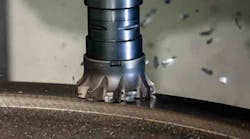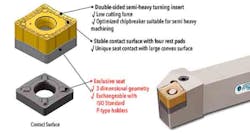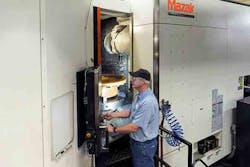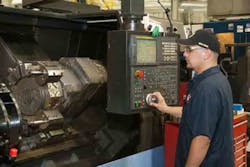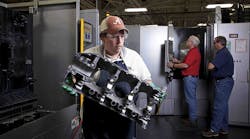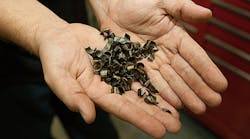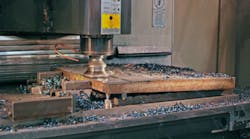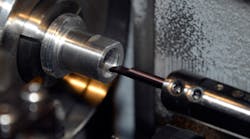You may think of rough turning as a bottleneck operation, maybe even a hazardous one, and rightly so. But, across the country several alert machine shops have found different ways around both problems, according to Ingersoll Cutting Tools. Users report material-removal rate improvements anywhere from 30% to 6-to-1 in OD and ID work, reliably longer tool life, and relief from ‘shrapnel’ flying from shattered tools.
DeZurik-APCO-Hilton, in Sartell, Minn., improved a host of valve-turning operations with the move to live turning at rates some people think could damage the spindle. On the first job, facing time on a large valve flange was reduced from 18 minutes to three, yet the spindle load reading rarely exceeded 50%. The C-axis spindle is equipped with an Ingersoll Hi-Quad F high-feed face mill that doubles as a full-depth face mill capable of depths of cut up to 0.200 in.
Micor Industries, Decatur, Ala., reduced rough-turning cycle time on titanium from 45 to 30 minutes with another Gold-Duty insert, shipping a rush order three days sooner. They’ve since standardized on that tool for all rough OD work, and are collaborating with Ingersoll to develop an ID-machining version — projecting the savings at around $500,000 per year.
“Titanium just complicates ID work with conventional tooling because of its unhelpful chipping characteristics,” said Ingersoll’s Darrell Boatwright. “The aggressive chipbreakers on the new Gold-Duty tool make short work of long chips in OD turning, and soon for ID work as well.”
Up in New England, a screw machine reconditioning shop boosted capacity by 30% on its fleet of Swiss Automatics using Gold-Duty CNMX 43.52 inserts. Their applications involve OD and ID work on wrought 8620 steel.
With its advanced design, substrates, and coatings, the Ingersoll Gold-Duty line of rough turning inserts is a generation ahead of the field in large scale turning, according to Ed Woksa, Ingersoll national turning product manager. The inserts are physically much thicker and stronger than conventional turning inserts. Their unique seating scheme enables more efficient top-face geometries in two-sided inserts for the first time. ‘Rest pads’ on the insert faces mate with bumps in the seat pocket to lock them in place (see diagram). It’s the rest pads that bear the clamping forces, not the cutting edges on the reverse side. This is what enables 5-7 degree positive rakes and aggressive chipbreakers in a two-sided insert. Recessed clamping provides a flush surface for unimpeded chip evacuation.
It should come as no surprise that live turning speeds up a roughing operation on any machine with a C axis. The process gets two spindles working simultaneously, with tools having multiple cutting edges rather than just one.
However, many auxiliary spindles are designed for light duty, unable to deploy the full capabilities of the high-performance face mills available today. “The trick in live turning is to find a cutter able to take deep cuts, yet hold down cutting forces,” said Ingersoll field engineer Brian Winterlin, who worked on the DeZurik live turning project.
Let’s first take a closer look at this application and then examine the more conventional ones.
First Stab at Live Turning
Until mid-2014, DeZurik rough-turned their big valve body workpieces with conventional stick tools on a heavy-duty VTL. Then, the company installed a large, five-axis Mazak mill/turn machine, which opened the door to live turning.
“The Mazak is a big ticket item with a high hourly burden, so it’s vital to get the most out of it,” said Chandler Commerford, manufacturing engineer. But, the Minnesota shop had no experience with the live turning process.
The incoming castings had the usual, wide piece-to-piece dimensional variations and yet needed a lot of stock removed depending on those inconsistencies. “Definitely not the ideal candidates for a first stab at a new kind of process,” said Commerford.
The main concern was to remove 0.200-0.400 in. of stock fast without overloading the auxiliary spindle, especially laterally. In flange work, low lateral forces are essential to keeping the flanges perfectly flat, preventing leaks when the valves go into service.
Ingersoll’s Brian Winterlin made a counterintuitive recommendation: a Hi-QuadF high-feed style cutter and taking off the stock in a single pass. That’s definitely beyond the ‘comfort zone’ for conventional high-feed cutters, which are known for fast feeds and shallow cuts. But the tool — though primarily a high-feed insert — had worked in similar high-depth applications “This is really an all-purpose cutter,” Winterlin added.
In a live-turning setup like this, the cutting forces are lighter than you might think, Winterlin explained. “As the tool rotates, its eleven inserts engage sequentially, dividing the cutting forces uniformly over them all. The stock comes off as a lot of small chips rather than the fewer thumb-size chips they were getting by turning with a stick tool.”
The Hi-QuadF face mill features an extra-thick insert with the usual high-feed radius, extremely rigid seating, free cutting geometry and a 12-degree lead angle for lower lateral forces at entry and exit. It is so free-cutting that, in similar applications elsewhere, it has doubled throughput without the spindle-load needle even budging.
Now, the DeZurik operation runs securely, cutting cycle time for a typical 36-in. flange from 18 minutes to three and leaving a perfectly flat mating surface. As the part rotates slowly on the machine table, the facemill works much like a woodworking router, rotating at 785 SFM and feeding outward from the center bore at 403 IPM. Synthetic oil is delivered through the spindle.
With the original Hi-Quad F insert, edges lasted through two complete parts, or four flanges. Recently the company switched to a tougher insert grade with an improved coating treatment, IN4005. The change notched edge life up another 50% at the same removal rates. Edges now last through three complete parts.
Debottlenecking Titanium Turning
Micor, which built its reputation machining difficult metals, was only midway through a 150-piece rush job turning titanium, and was running late already. But, the tools they were using, with conventional two-sided negative rake inserts, broke whenever they tried to run any faster than 130 SFM/0.010 IPR/0.200 DOC. That operation, on a Mazak Quik Turn 450, was taking 45 minutes per piece, while the finishing machine nearby stood idle, waiting for feedstock.
“The Mazak had the power to cut faster; the bottleneck was the tool,” Ingersoll field rep Darrell Boatwright observed during a plant walk-through. He brought in a Gold-Duty cutter he had in the trunk and they tried it out on the spot. By the end of the day, parameters were optimized at 100SFM/0.014IPR/0250 DOC.
The Gold-Duty tool easily handled the 33% higher machining rates with no pounding or scraping, the usual forerunners of an insert about to rupture. “We slowed the surface speed but fed faster and cut deeper,” explained Micor programmer Joey King.
Micor standardized on those settings for the balance of the job, and delivered the job three days early as a result. “Despite the higher removal rates, the inserts lasted 33% longer,” King added. He estimated that, with an annual volume of 400-500 pieces, Micor would save $13,000 a year on that one titanium job. Consequently Micor is standardizing on Gold-Duty tooling for all rough turning and facing, for a projected $60,000 annual savings.
The main obstacle in the New England rebuilder’s effort to raise capacity of its screw machine fleet was the boring sequence, which represented more than half the total machine time. The shop still used conventional, negative-rake boring tools, a carryover from the time when most of the work they took in involved free-machining mild steels. When more work came in that called for long-chipping 8620 steel, they simply accepted as an unavoidable detail the 100% operator attention for chip clearance.
Switching to Ingersoll TCMT boring inserts with higher rakes, more aggressive chipbreakers and the proprietary TT8125 coating led directly to 30% higher machining rates. It also completely eliminated any ‘bird nests’ of chips and the labor involved to clear them. Chips flow out as uniform C’s, easily cleared with a shot of compressed air.
The same types of tooling also increased OD removal rates, enabling the whole fleet of screw machines to reach the shop managers’ goal of 30% higher capacity with no capital expenditures. “Even in miniature precision screw machine work, today’s higher-rake, chipbreaking inserts with advanced coatings can make a material difference,’ said Ingersoll’s Matt Hagenow, who worked on this project.
